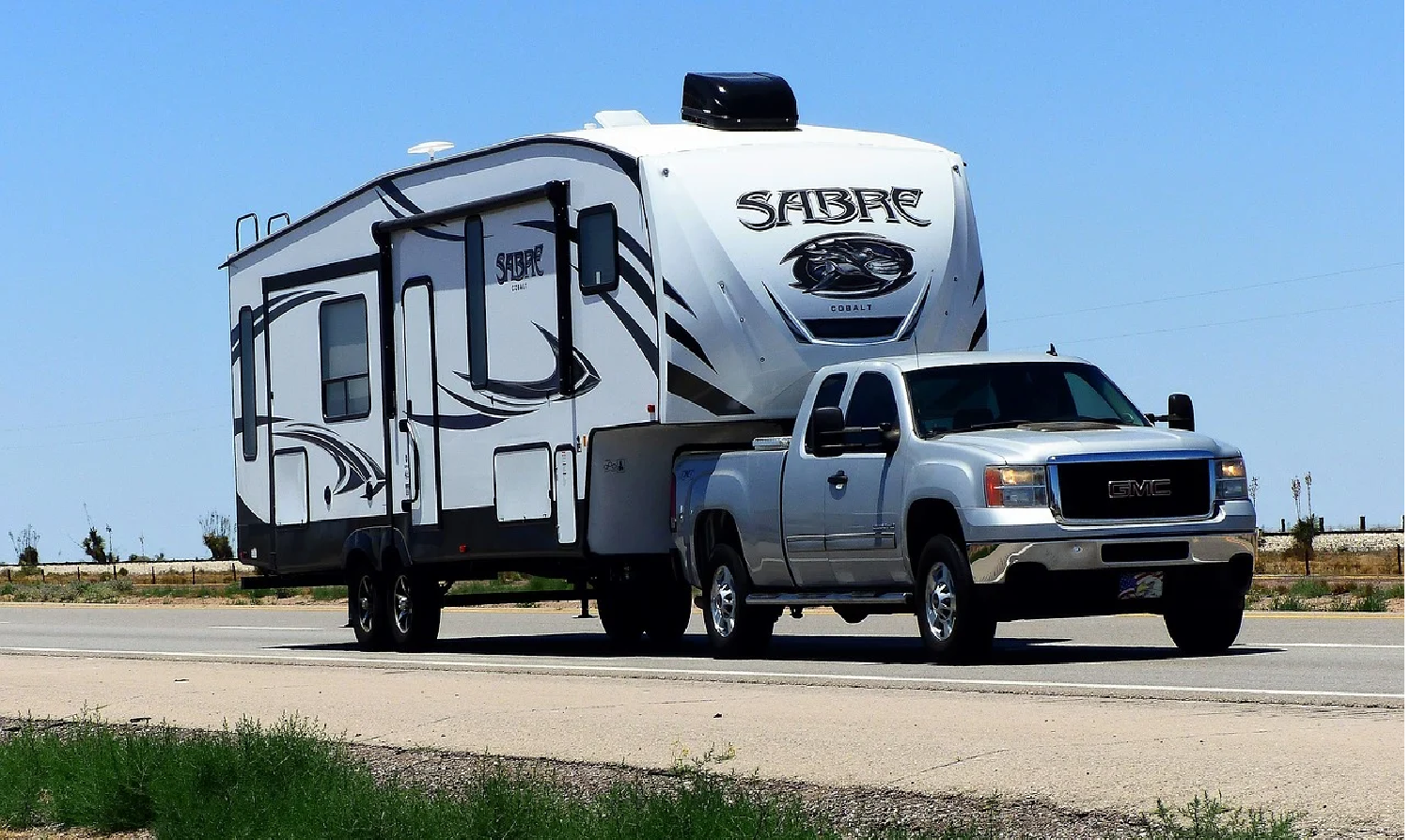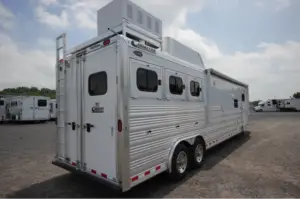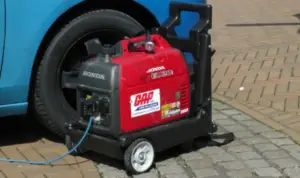Some of the most beautiful campgrounds need you to park on bumpy terrain. However, leaving your RV on an unstable surface or incline means your camper will be wiggling and tipping each time you take a step.
RV levelling blocks work well for motorhomes with four wheels on the ground, but travel trailers and fifth wheels need a different stabilizer type. In this article, we will exclusively look at how to stabilize the fifth wheel RV.
Why Do My Fifth Wheel Shakes
Travel and fifth-wheel trailers are supported by tires and wheels, both of which have been designed to be relatively flexible. But why does it wiggle and shake when parked? This is because everything you set up moves; hence the fifth trailer has movements.
Well, tires contain air and are flexible hence make the trailer shake when we walk in it. More so, the RV has suspension springs that are flexible by definition.
So while the tires and spring flexibility is excellent for giving you a smooth ride during your camping adventures, it is a cause of shaking at the campsite when walking in your Fifth wheel RV.
Another major cause of shaking on your fifth wheel RV is the sloppy fit of the landing gear. This consists of three square tubes at the camper’s front that moves up and down to level the trailer and enhance the hitching process. The tubes have some slop in them to allow them to move.
Even more, if the campgrounds are not completely solid, the stabilizer equipment base will move, and ultimately the trailer and the device will move.
More so, if the blocks used for supporting the stabilizing equipment are not appropriately placed and are flexible, the stabilizer and the trailer will shake. Even more, if the jack stabilizer or tripod has any sideways flexibility or moves up and down, the equipment and the trailer will have movements.
Why Stabilize Your Fifth Wheel
Stabilizers are primarily used for fifth wheels and towable travel trailers. They have been designed to inhibit any movement after parking your camper. Nobody will want to spend time in an RV that moves back and forth or feels like it’s sinking in the ground. It is hard to relax in an RV that is not level.
It is not only uncomfortable, but the RV might be damaged if it sits off-balance for so long. More so, uneven weight distribution escalates the risk of tire damage.
Unluckily, tire damage is among the leading causes of RV accidents; hence it is essential to avoid weight imbalances when parking. Additionally, if you have an absorption refrigerator, it is vital to have a well-levelled RV. Absorption refrigerators are designed to function at an angle.
How Many Stabilizers Do You Require?
Stabilizing your RV will make it more convenient to spend your camping adventures and increase its value if you choose to sell it with some stabilizer gear attached. The number of stabilizers you require depends on your type of vehicle.
Most of the travel trailers, however, need at least four stabilizers. Because fifth-wheel trailers have a unique weight distribution, they usually require more stabilizers near the rear than the front.
In the end, it comes down to weight. You should understand the Gross Vehicle Weight Rating for your RV, which is the maximum capacity the RV can carry safely.
While it’s not likely you will drive the RV when loaded to the maximum capacity, the number is applicable when purchasing stabilizers. Check out the stabilizer capacity and use stabilizers that significantly exceeds the weight limit of your vehicle.
Types of Stabilizers
There are different types of RV stabilizer jacks. These include; scissors, tripods, SteadyFast and universal stabilizers. Each of these stabilizers is designed a bit differently, and they each have their own pros.
Scissor Stabilizers
These stabilizers have a similar look to trailer jacks. Scissor stabilizers use a crank handle to rise from the ground to the fifth wheel RV base. The stabilizers are easy to assemble particularly effective in preventing bouncing movements.
Even if they look like a jack, you should never use scissor stabilizers to jack a trailer. They have been used for side-to-side stabilization rather than holding the total weight capacity of a camper.
SteadyFast Stabilizers
This is a brand that makes stabilizers for travel trailers and fifth wheels. SteadyFast stabilizers are permanently installed, so you only have to attach them once.
They will be tightened to level your camper in less than 45 seconds. These stabilizers provide excellent protection against both side-to-side bouncing and movement. These are the most effective stabilizers you can purchase for your fifth wheel RV, but they are also relatively costly.
Tripod stabilizers
As their name suggests, these stabilizers feature three feet that touch the trailer with a single contact point underneath the RV. They are pretty fast and easy to install, needing no special skills or equipment. Tripod stabilizers are effective in preventing side-side movements but are not ideal for averting bouncing movements.
Universal stabilizers
These are the catch-all term that refers to stabilizers that come pre-attached to an RV. When you buy a new camper, they often come with universal stabilizers.
These stabilizers might and might not be enough to completely secure the camper depending on the type of camp terrain you park on and how much weight you put on it. If the universal stabilizers are not effective enough, you can buy replacement stabilizers that are easy to crank down and mount into place.
How to Make Fifth Wheel More Stable
So, what can be done to get rid of the most annoying movements and offer a solid feeling without performing any amount of work every time you set it up? You should make efforts to make your fifth wheel more stable.
This is by working against the flexible parts and try taming them as much as possible to establish stability between the RV and the ground. This is by making sure you take the most basic measures. The best way of making your fifth wheel RV stable will include several methods, each customized for a particular section to be stabilized.
Before anything else, you should ensure your tires have enough maximum pressure recommended by the manufacturer, and the tire lugs are tight.
The first step in stabilizing your fifth-wheel trailer is levelling it first. A level RV will ensure that slides and doors will open easily and the fridge will be running appropriately. Ensure the levelling blocks are evenly distributed so that the vehicle is level overall.
When it comes to the landing gear, one way of stabilizing your fifth wheel is using hard solid levelling blocks that are sufficiently large to support the jack weight on the surface you are on.
Using several wood blocks is the least expensive option and ensures the landing gear is not significantly extended, and less extension means it will have less slop. None might be required on concrete, but a considerable surface area might be needed on the sand.
However, you should be careful when setting the blocks to ensure they are not on an uneven surface that will facilitate them to rock. It might be essential to use some more giant jack pads for them to self-level under the pad.
Now that your RV is levelled, you can use various ways to help stabilize your RV. This includes putting the wheel chocks in place as well as extending the RV stabilizer jacks.
You will require four stabilizer jacks, one on every corner of the RV. For the fifth wheel RV, you should place a tripod jack for the kingpin at the front of the camper to stabilize the fifth wheel’s nose. A tripod effectively stabilizes the front end of the trailer, with the only con being that they can be heavy, and you need to find a place to store them.
Another effective method is using stabilizing bars. Although effective in stabilizing your fifth wheel RV, they might add weight to the trailer, plus most fifth wheels lack a sufficient frame member to use on the attachments. You might hence end being forced to modify the frame to use them.
More so, they function best when some load is placed on them. This is not easily done with a levelling system as you often require to do the levelling manually for best results.
To stabilize the rear, lots of people prefer X-Chocks, brackets placed between the tandem tires on each side. After being placed, the X-chocks are bound down until they exert pressure on the tires so that they can’t move forward or backwards.
However, these work better with the RVs without using the levelling system. It is also essential to use some wheel chocks to prevent your RV from moving, mainly if the park site is not level as well as during the hitching process.
A set of manual jacks on your RV rear can also enhance its stability. Nevertheless, the best solution for stabilizing your fifth wheel RV will depend on the type of levelling or the stabilizing system you have and will be a combination of these different solutions.
Some Best Stabilizers to Buy
X-chock Wheel Stabilizer
One of the easiest ways of stabilizing your camper is ensuring the wheels cannot move. Although the wheel chocks might reduce the rocking, the tires will still remain relatively free to move and wobble. This is where the X-chock come in. they are placed between the tires and tighten until they are in place. This will stop the tires from moving when you walk around. The X-chocks are retailed as a pair and feature a wrench tool used for their installation between the tires. Being lightweight and easy to install, the X-Chock wheel stabilizer is an excellent starter for stabilizing your fifth wheel RV.
SteadyFast Stabilizer
The SteadyFast Stabilizer is one of the most sought-after systems by the fifth wheel. This permanently installed design can be easily mounted on a trailer with four jacks (2 in the rear and 2 in the front). After being installed, the SteadyFast stabilizer can be set up less than a minute after reaching the campground. The best thing about this stabilizer is that it has a speedy assembly and doesn’t need you to go under the camper. It also comes with its own footplates. It effectively reduces swaying while you won’t have to worry about loading and unloading the jacks.
Camco 2-Pack Aluminum Camper Jack
Camco campers are a top choice when it comes to tripod stabilizers. This tripod function as a jack and stabilizers, so they are very sturdy. The design is straightforward. You only need to twist a handle to crank the jack into place. They are designed from cast aluminum with a water-resistant coating. Every jack can hold up about 6000 pounds and the stabilizers are adjustable between 11 to 17 inches. This Camco 2-Pack Aluminum camper jack is easy to use and reliable.
Lippert 191023 JT Strong Arm Fifth-Wheel Jack Stabilizer
The first thing to keep in mind is that there are different Lippert jack stabilizer models available based on your trailer type. The Lippert 191023 JT’s Strong Arm Fifth-Wheel Jack Stabilizer is designed for fifth-wheel RVs, while the Lippert 191025 JT’s Strong Arm Fifth-Wheel Jack Stabilizer Kit is meant for travel trailers. This stabilizer uses racecar suspension technology to remove your RV’s shaking and wobbly movement, something that stabilizer jacks cannot achieve on their own. The kit is permanently installer on your RV stabilizer jacks, and you will only need to tighten the bars for it to move into place. Although it is a more advanced stabilizing solution that needs more skills and time to install, it is better at eliminating shaky movements.
Conclusion
A shaking fifth-wheel trailer is pretty common, and it is relatively easy to fix. These RV stabilizer jacks will help decrease movement when parked on uneven ground. You cannot always predict the ground conditions where you camp and park your V. however, with the right stabilizer, you can stay secure and comfortable in your fifth RV on all types of terrain. It’s recommendable, to begin with, the basic and then if the trailer is still shaking, find out the cause before purchasing more stabilizer gears.





